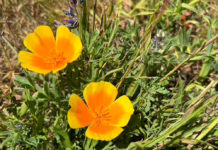Planning ahead is one of the most important activities we can perform, particularly if you want things to turn out to your satisfaction. Unlike Mother Nature, who can throw together a meadow and have it beautiful, we must think, act, and follow up in order to reach our goal.
In the garden, we continually read of October’s excellence providing us with a golden opportunity to have lovely winter flower, tree and shrub displays, let alone the festival of flora which blooms in our early spring.
For the most part we are cognizant of only the drying and dying of our summer gardens. Things are really looking ratty right now. If the summer flowers aren’t leggy and bent they will be and we know it. Leaves are turning and will supply us with our very own “New England Color Show,” lasting longer than Vermont’s, into Thanksgiving.
The other day it occurred to me that while most plants are shutting down along with the laying hens, others are awakening. Camellias, primulas, pansies and violas soon will fill our need for color and table flowers.
Why are they springing to life when other plants are shutting down or downright dying?
It all has to do with hormones. Doesn’t everything? In vegetation those hormones are called phytohormones and they are chemicals that dictate shape, seed growth, time of flowering, sex of flowers, senescence of leaves (biological aging), fruits — in other words cellular division and tissue growth.
Plants need a rest period and they also need protection from extreme heat or cold. Therefore, in both conditions, most plants shut down for awhile, to protect themselves. They do this by going dormant, temporarily losing their plasticity or their ability to form new tissue. Deciduous trees send all of their sugars to their roots for storage.
Evergreens continue to photosynthesize and respirate but at a much reduced level.
If these extreme cold or heat sensitive plants did not go into dormancy, they would be seriously injured, possibly die.
On the other hand, there are a few hardy souls, like pansies, primulas and camellias whose DNA are totally comfortable with the cold of Sonoma County.
Pansies will survive winter temperatures of 40 degrees below zero!
Many of our cold weather color are native to China, as are camellias, so their plant hormones are programmed differently than, say, a zinnia flower which is native to Mexico.
With planning we can successfully prepare a garden for winter. Our local nurseries are filled with cool weather flowers and shrubs. By Christmas the calendulas and the cyclamen will be beautiful!
Speaking of good planning and the virtues thereof, I was following that urge when my family was driving to Oregon last June. It was to be a long drive up I-5 taking the bulk of the day. We had a vacation rental awaiting us and most of the Kiffs would be housed there for four days, attending the wedding of our eldest granddaughter.
At breakfast at the restaurant near Orland there was the typical caddy of Smucker jams. Always a jam fan, I thought about the four breakfasts our gang would be providing for ourselves at the vacation house. Wouldn’t it be nice to have an assortment of little jam packets? I gathered a bunch of them, embarrassing both my sister and daughter.
A month ago I needed a quarter and I can always find one in the bottom of my purse. Indeed, there it was, but it was stuck to a nickel and a penny and a whole lot of dust.
“Oh, darn, I guess I have a Lifesaver package that opened up down there.”
I dismissed the stickiness and pursued my life for a number of weeks until the other day when I reached for a pen and it was stuck to my lead bookkeeping pencil.
Then and there I knew the truth. I never brought the Smuckers out of my purse. They’ve been there all summer.
At Big John’s Market, I reached for my wallet and it was stuck to my notepad which was stuck to my handy-dandy Chico bag for groceries. I apologized to the bagger that it might be sticky.
Today I am planning to purge my purse — after I water the primroses. First things first!
Renee Kiff weeds and writes at her family farm in Alexander Valley.
54.8
F
Healdsburg
July 12, 2025








